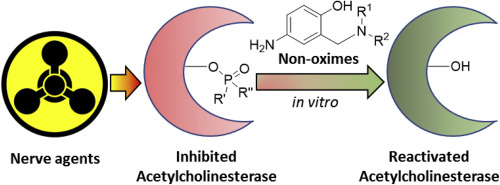European Journal of Medicinal Chemistry ( IF 6.0 ) Pub Date : 2018-08-06 , DOI: 10.1016/j.ejmech.2018.08.016 Martijn Constantijn de Koning , Gabriele Horn , Franz Worek , Marco van Grol

|
Organophosphorous (OP) compounds (such as nerve agents) inhibit the enzyme acetylcholinesterase (AChE) by covalent phosphylation of a key serine residue in the active site of the enzyme resulting in severe symptoms and ultimately death. OP intoxications are currently treated by administration of certain oxime compounds. The presently fielded oximes reactivate OP-inhibited AChE by liberating the phosphylated serine. Recent research towards new reactivators was predominantly devoted to design, synthesis and evaluation of new oxime-based compounds dedicated to overcoming some of the major limitations such as their intrinsic toxicity, their permanent charge which thwarts penetration of brain tissues and their inability to effectively reactivate all types of nerve agent inhibited AChEs. However, in over six decades of research only limited success has been achieved, indicating that there is a need for alternative classes of compounds that could reactivate OP-inhibited AChE. Recently, a number of non-oxime compounds was discovered in which the 4-amino-2-((diethylamino)methyl)phenol (ADOC) motif proved to be able to reactivate OP-inhibited AChE to some extent. In this paper several structural derivatives of ADOC were synthesized and screened for their ability to reactivate human AChE (hAChE) inhibited by the nerve agents VX, sarin, tabun, cyclosarin and paraoxon. We here disclose that one of those compounds showed a remarkable ability to reactivate OP-inhibited hAChE in vitro and that it is the most potent non-oxime reported to date.
中文翻译:

发现一种有效的神经药非肟激活剂抑制人乙酰胆碱酯酶
有机磷(OP)化合物(例如神经毒剂)通过在酶活性部位的关键丝氨酸残基进行共价磷酸化来抑制乙酰胆碱酯酶(AChE),从而导致严重的症状并最终导致死亡。目前通过给予某些肟化合物来治疗OP中毒。目前获得的肟通过释放磷酸化的丝氨酸来重新激活OP抑制的AChE。最近对新型活化剂的研究主要致力于设计,合成和评估基于肟的新型化合物,这些化合物致力于克服一些主要局限性,例如其固有毒性,阻碍大脑组织渗透的永久电荷以及无法有效活化所有活性物质。类型的神经毒剂抑制了AChEs。然而,在超过六十年的研究中,仅取得了有限的成功,这表明需要能够重新激活OP抑制的AChE的其他类别的化合物。最近,发现了许多非肟化合物,其中4-氨基-2-((二乙基氨基)甲基)苯酚(ADOC)母题被证明能够在一定程度上重新激活OP抑制的AChE。在本文中,合成了ADOC的几种结构衍生物,并筛选了它们重新激活被神经毒剂VX,沙林,塔宾,环沙蛋白和对氧磷抑制的人AChE(hAChE)的能力。我们在此公开了这些化合物之一在体外显示出显着的重新激活OP抑制hAChE的能力,并且它是迄今为止报道的最有效的非肟化合物。这表明需要可以重新激活OP抑制的AChE的替代化合物。最近,发现了许多非肟化合物,其中4-氨基-2-((二乙基氨基)甲基)苯酚(ADOC)母题被证明能够在一定程度上重新激活OP抑制的AChE。在本文中,合成了ADOC的几种结构衍生物,并筛选了它们重新激活被神经毒剂VX,沙林,塔宾,环沙蛋白和对氧磷抑制的人AChE(hAChE)的能力。我们在此公开了这些化合物之一在体外显示出显着的重新激活OP抑制hAChE的能力,并且它是迄今为止报道的最有效的非肟化合物。这表明需要可以重新激活OP抑制的AChE的替代化合物。最近,发现了许多非肟化合物,其中4-氨基-2-((二乙基氨基)甲基)苯酚(ADOC)母题被证明能够在一定程度上重新激活OP抑制的AChE。在本文中,合成了ADOC的几种结构衍生物,并筛选了它们重新激活被神经毒剂VX,沙林,塔宾,环沙蛋白和对氧磷抑制的人AChE(hAChE)的能力。我们在此公开了这些化合物之一在体外显示出显着的重新激活OP抑制hAChE的能力,并且它是迄今为止报道的最有效的非肟化合物。发现了许多非肟化合物,其中4-氨基-2-(((二乙基氨基)甲基)苯酚(ADOC)基序证明能够在某种程度上重新激活OP抑制的AChE。在本文中,合成了ADOC的几种结构衍生物,并筛选了它们重新激活被神经毒剂VX,沙林,塔宾,环沙蛋白和对氧磷抑制的人AChE(hAChE)的能力。我们在此公开了这些化合物之一在体外显示出显着的重新激活OP抑制hAChE的能力,并且它是迄今为止报道的最有效的非肟化合物。发现了许多非肟化合物,其中4-氨基-2-(((二乙基氨基)甲基)苯酚(ADOC)基序证明能够在某种程度上重新激活OP抑制的AChE。在本文中,合成了ADOC的几种结构衍生物,并筛选了它们重新激活被神经毒剂VX,沙林,塔宾,环沙蛋白和对氧磷抑制的人AChE(hAChE)的能力。我们在此公开了这些化合物之一在体外显示出显着的重新激活OP抑制hAChE的能力,并且它是迄今为止报道的最有效的非肟化合物。





















































 京公网安备 11010802027423号
京公网安备 11010802027423号